Public Health Promotion Project: Controlling Obesity in Teenagers
VerifiedAdded on 2022/10/17
|13
|3076
|287
Report
AI Summary
This report presents a comprehensive public health promotion project designed to address the growing concern of obesity among teenagers. The project focuses on a target group of 12-17 year olds in South Sydney schools, aiming to control obesity through a multifaceted approach. The plan outlines specific, measurable, achievable, relevant, and time-bound (SMART) goals, emphasizing the importance of prevention and management strategies. It details the involvement of stakeholders such as doctors, nurses, dieticians, and community sports clubs to ensure the project's success. The health message, "Exercise, eat, sleep and repeat," underscores the core principles of a healthy lifestyle. The project's activities are divided into counseling and practical phases, including educational sessions, personalized diet plans, and physical activities. The evaluation proposal suggests using formative evaluation to assess the program's impact, focusing on changes in eating habits, self-care behaviors, and physical exercise. The report concludes with a reflection on the project's effectiveness and challenges, highlighting the importance of a well-structured plan to promote health among teenagers and their families. The project emphasizes the role of family support, personalized diet plans, and exercise routines in reducing obesity, aiming to provide long-term health benefits for the target group.
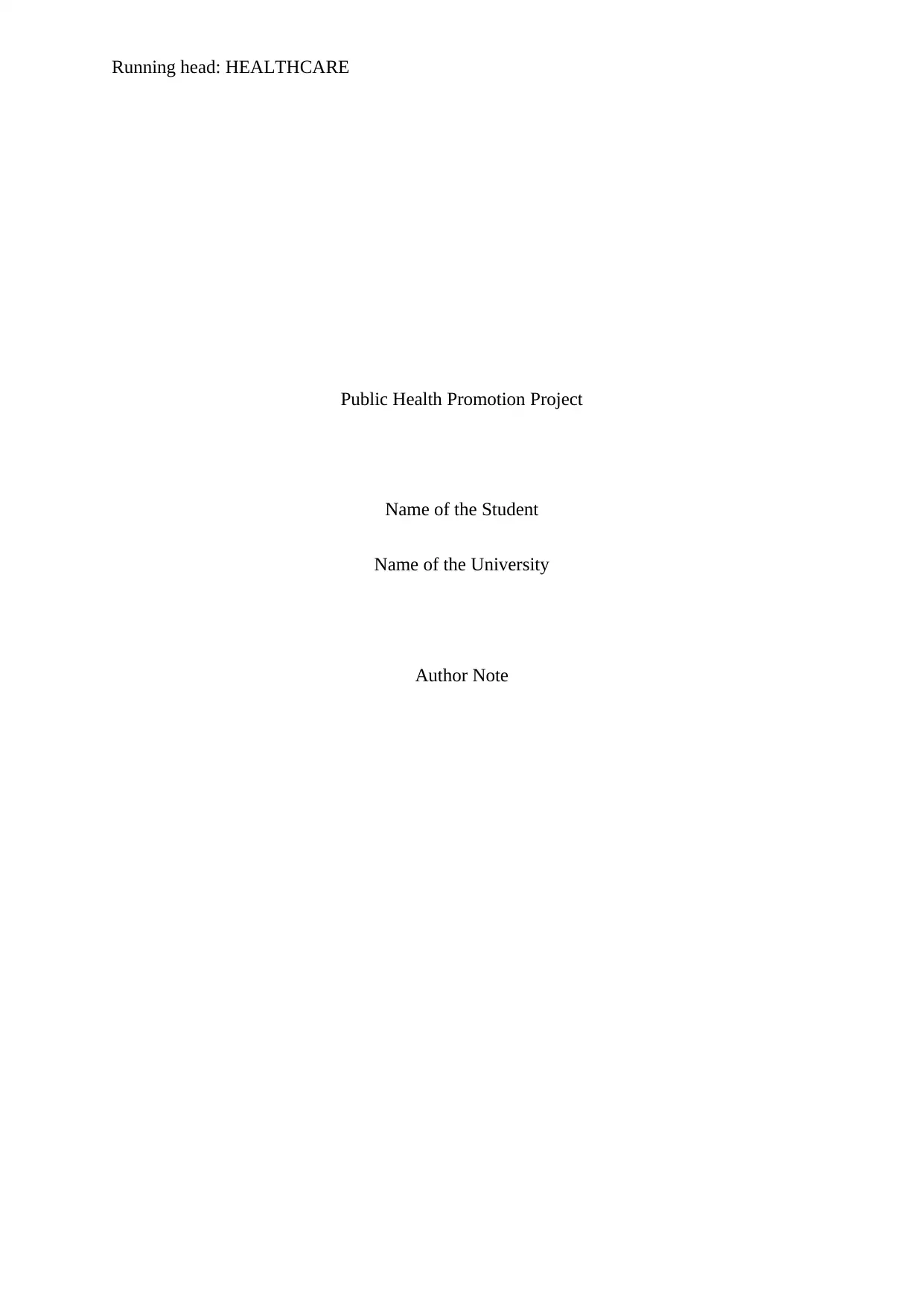
Running head: HEALTHCARE
Public Health Promotion Project
Name of the Student
Name of the University
Author Note
Public Health Promotion Project
Name of the Student
Name of the University
Author Note
Paraphrase This Document
Need a fresh take? Get an instant paraphrase of this document with our AI Paraphraser
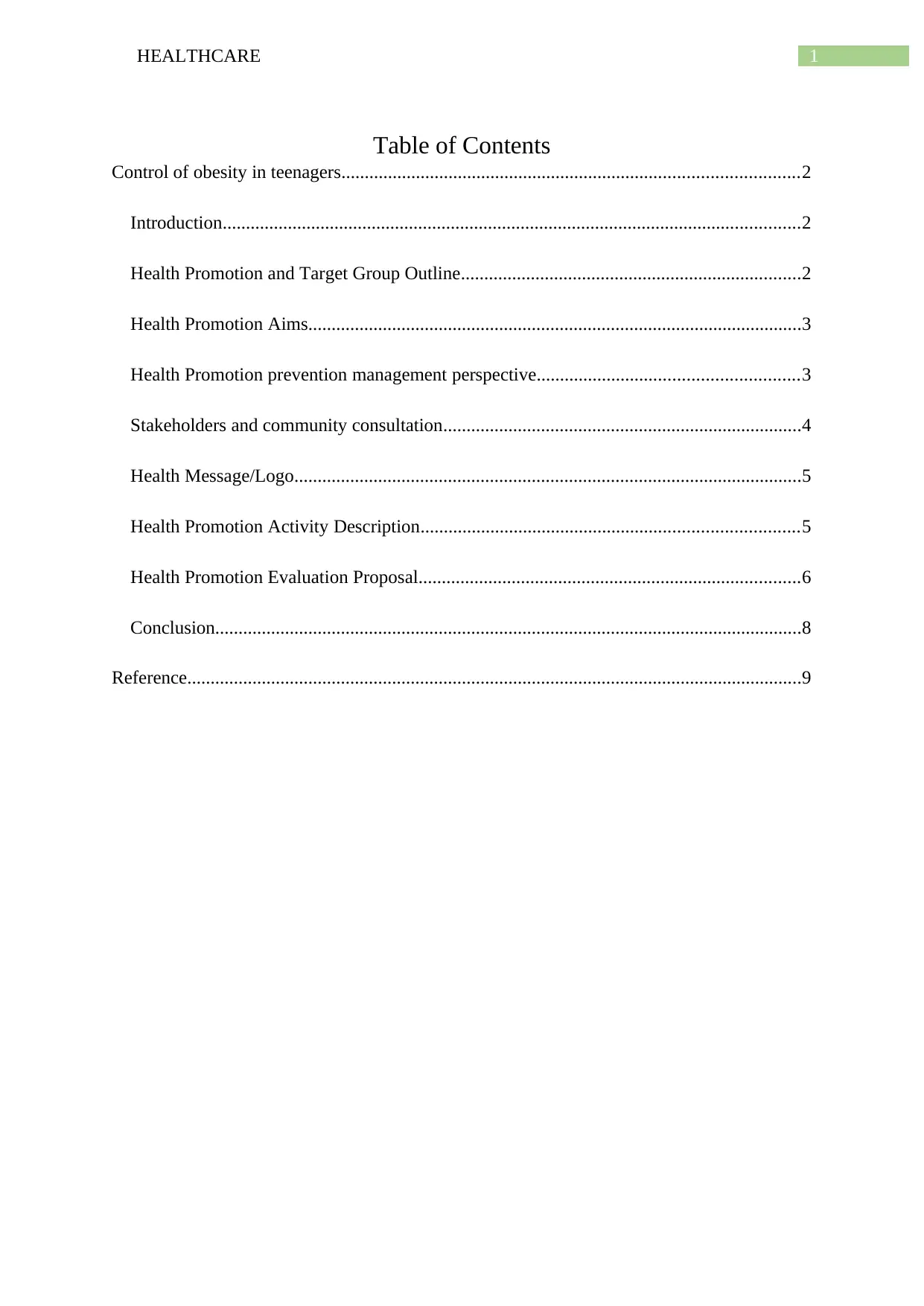
1HEALTHCARE
Table of Contents
Control of obesity in teenagers..................................................................................................2
Introduction............................................................................................................................2
Health Promotion and Target Group Outline.........................................................................2
Health Promotion Aims..........................................................................................................3
Health Promotion prevention management perspective........................................................3
Stakeholders and community consultation.............................................................................4
Health Message/Logo.............................................................................................................5
Health Promotion Activity Description.................................................................................5
Health Promotion Evaluation Proposal..................................................................................6
Conclusion..............................................................................................................................8
Reference....................................................................................................................................9
Table of Contents
Control of obesity in teenagers..................................................................................................2
Introduction............................................................................................................................2
Health Promotion and Target Group Outline.........................................................................2
Health Promotion Aims..........................................................................................................3
Health Promotion prevention management perspective........................................................3
Stakeholders and community consultation.............................................................................4
Health Message/Logo.............................................................................................................5
Health Promotion Activity Description.................................................................................5
Health Promotion Evaluation Proposal..................................................................................6
Conclusion..............................................................................................................................8
Reference....................................................................................................................................9
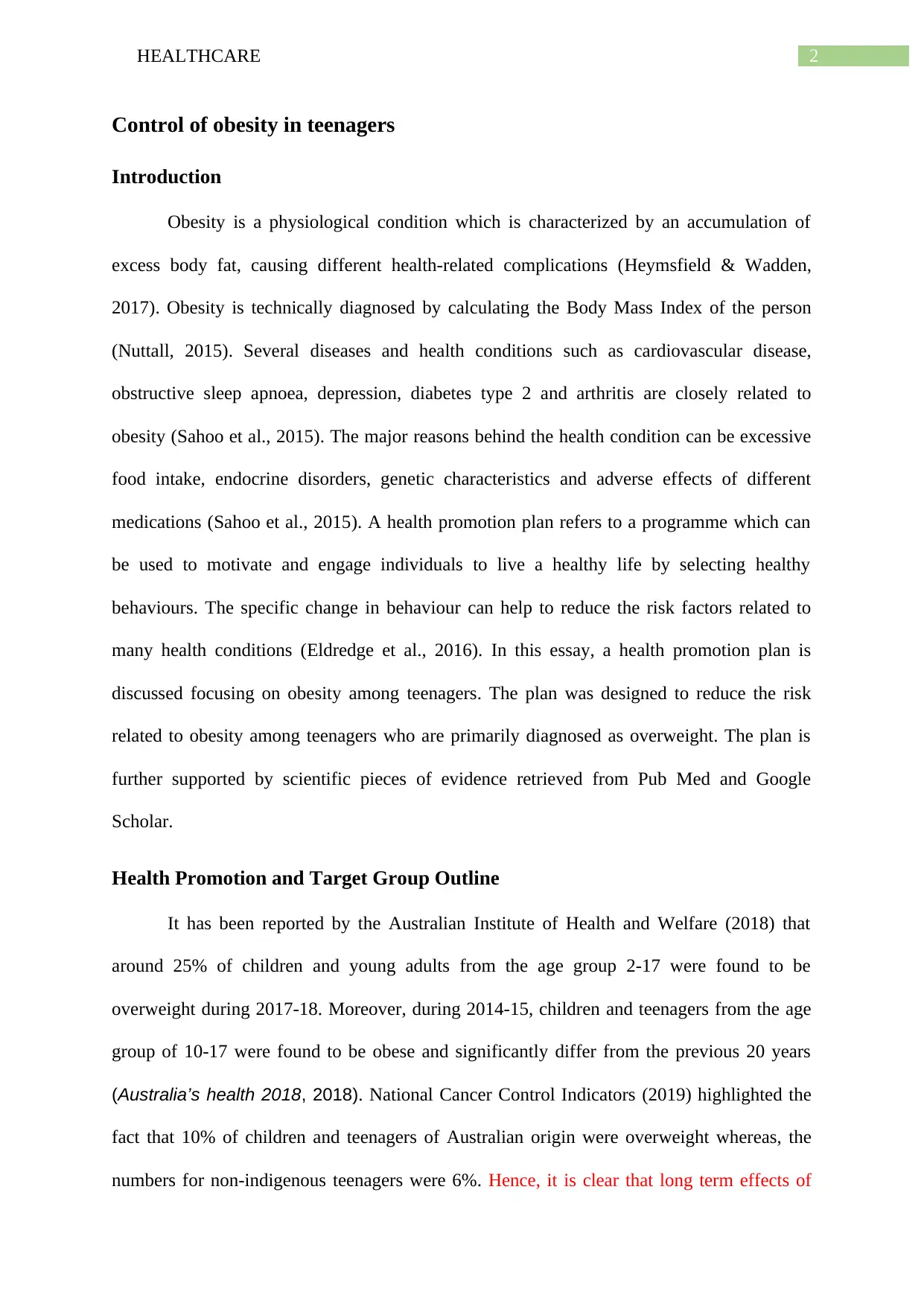
2HEALTHCARE
Control of obesity in teenagers
Introduction
Obesity is a physiological condition which is characterized by an accumulation of
excess body fat, causing different health-related complications (Heymsfield & Wadden,
2017). Obesity is technically diagnosed by calculating the Body Mass Index of the person
(Nuttall, 2015). Several diseases and health conditions such as cardiovascular disease,
obstructive sleep apnoea, depression, diabetes type 2 and arthritis are closely related to
obesity (Sahoo et al., 2015). The major reasons behind the health condition can be excessive
food intake, endocrine disorders, genetic characteristics and adverse effects of different
medications (Sahoo et al., 2015). A health promotion plan refers to a programme which can
be used to motivate and engage individuals to live a healthy life by selecting healthy
behaviours. The specific change in behaviour can help to reduce the risk factors related to
many health conditions (Eldredge et al., 2016). In this essay, a health promotion plan is
discussed focusing on obesity among teenagers. The plan was designed to reduce the risk
related to obesity among teenagers who are primarily diagnosed as overweight. The plan is
further supported by scientific pieces of evidence retrieved from Pub Med and Google
Scholar.
Health Promotion and Target Group Outline
It has been reported by the Australian Institute of Health and Welfare (2018) that
around 25% of children and young adults from the age group 2-17 were found to be
overweight during 2017-18. Moreover, during 2014-15, children and teenagers from the age
group of 10-17 were found to be obese and significantly differ from the previous 20 years
(Australia’s health 2018, 2018). National Cancer Control Indicators (2019) highlighted the
fact that 10% of children and teenagers of Australian origin were overweight whereas, the
numbers for non-indigenous teenagers were 6%. Hence, it is clear that long term effects of
Control of obesity in teenagers
Introduction
Obesity is a physiological condition which is characterized by an accumulation of
excess body fat, causing different health-related complications (Heymsfield & Wadden,
2017). Obesity is technically diagnosed by calculating the Body Mass Index of the person
(Nuttall, 2015). Several diseases and health conditions such as cardiovascular disease,
obstructive sleep apnoea, depression, diabetes type 2 and arthritis are closely related to
obesity (Sahoo et al., 2015). The major reasons behind the health condition can be excessive
food intake, endocrine disorders, genetic characteristics and adverse effects of different
medications (Sahoo et al., 2015). A health promotion plan refers to a programme which can
be used to motivate and engage individuals to live a healthy life by selecting healthy
behaviours. The specific change in behaviour can help to reduce the risk factors related to
many health conditions (Eldredge et al., 2016). In this essay, a health promotion plan is
discussed focusing on obesity among teenagers. The plan was designed to reduce the risk
related to obesity among teenagers who are primarily diagnosed as overweight. The plan is
further supported by scientific pieces of evidence retrieved from Pub Med and Google
Scholar.
Health Promotion and Target Group Outline
It has been reported by the Australian Institute of Health and Welfare (2018) that
around 25% of children and young adults from the age group 2-17 were found to be
overweight during 2017-18. Moreover, during 2014-15, children and teenagers from the age
group of 10-17 were found to be obese and significantly differ from the previous 20 years
(Australia’s health 2018, 2018). National Cancer Control Indicators (2019) highlighted the
fact that 10% of children and teenagers of Australian origin were overweight whereas, the
numbers for non-indigenous teenagers were 6%. Hence, it is clear that long term effects of
⊘ This is a preview!⊘
Do you want full access?
Subscribe today to unlock all pages.

Trusted by 1+ million students worldwide
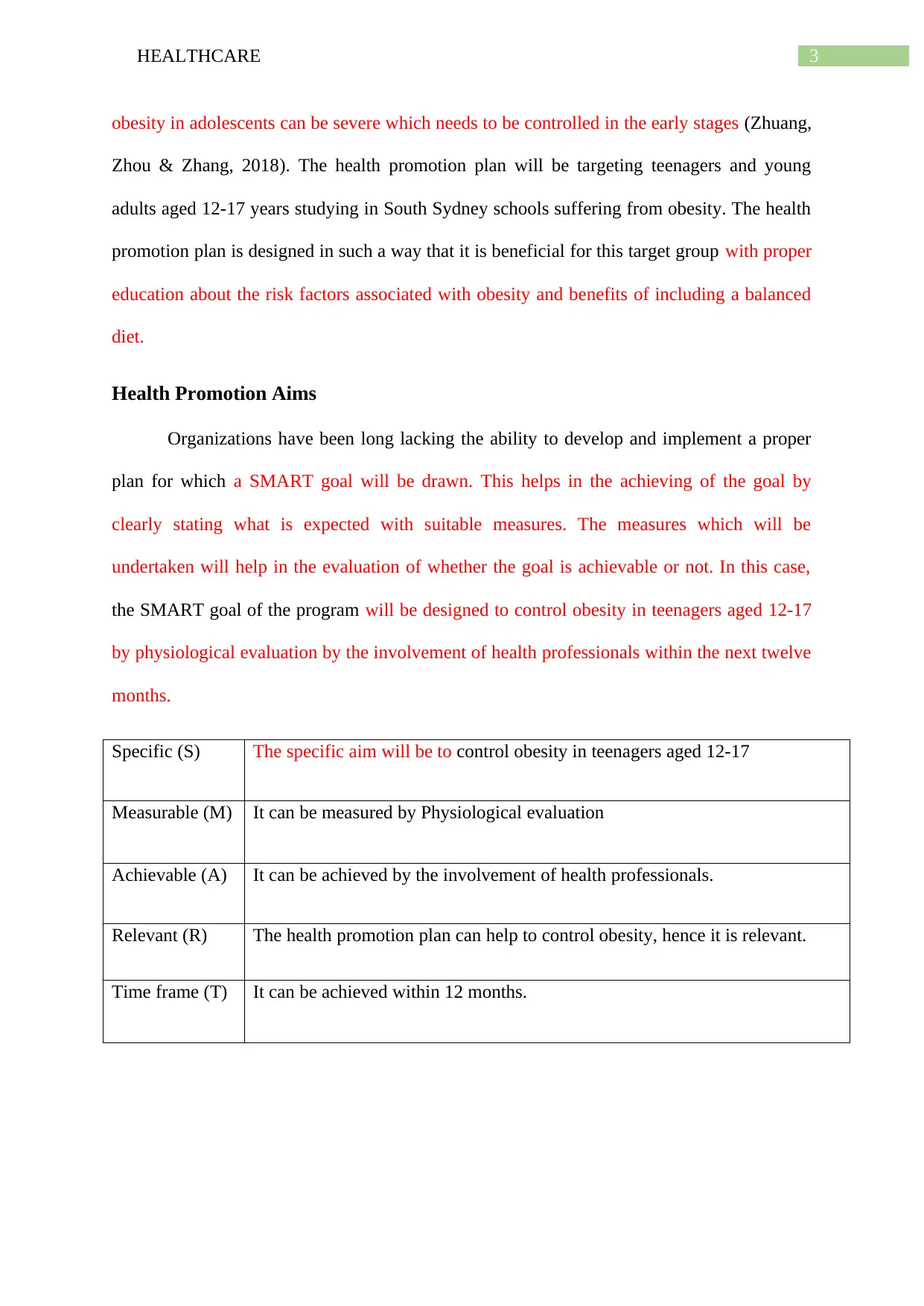
3HEALTHCARE
obesity in adolescents can be severe which needs to be controlled in the early stages (Zhuang,
Zhou & Zhang, 2018). The health promotion plan will be targeting teenagers and young
adults aged 12-17 years studying in South Sydney schools suffering from obesity. The health
promotion plan is designed in such a way that it is beneficial for this target group with proper
education about the risk factors associated with obesity and benefits of including a balanced
diet.
Health Promotion Aims
Organizations have been long lacking the ability to develop and implement a proper
plan for which a SMART goal will be drawn. This helps in the achieving of the goal by
clearly stating what is expected with suitable measures. The measures which will be
undertaken will help in the evaluation of whether the goal is achievable or not. In this case,
the SMART goal of the program will be designed to control obesity in teenagers aged 12-17
by physiological evaluation by the involvement of health professionals within the next twelve
months.
Specific (S) The specific aim will be to control obesity in teenagers aged 12-17
Measurable (M) It can be measured by Physiological evaluation
Achievable (A) It can be achieved by the involvement of health professionals.
Relevant (R) The health promotion plan can help to control obesity, hence it is relevant.
Time frame (T) It can be achieved within 12 months.
obesity in adolescents can be severe which needs to be controlled in the early stages (Zhuang,
Zhou & Zhang, 2018). The health promotion plan will be targeting teenagers and young
adults aged 12-17 years studying in South Sydney schools suffering from obesity. The health
promotion plan is designed in such a way that it is beneficial for this target group with proper
education about the risk factors associated with obesity and benefits of including a balanced
diet.
Health Promotion Aims
Organizations have been long lacking the ability to develop and implement a proper
plan for which a SMART goal will be drawn. This helps in the achieving of the goal by
clearly stating what is expected with suitable measures. The measures which will be
undertaken will help in the evaluation of whether the goal is achievable or not. In this case,
the SMART goal of the program will be designed to control obesity in teenagers aged 12-17
by physiological evaluation by the involvement of health professionals within the next twelve
months.
Specific (S) The specific aim will be to control obesity in teenagers aged 12-17
Measurable (M) It can be measured by Physiological evaluation
Achievable (A) It can be achieved by the involvement of health professionals.
Relevant (R) The health promotion plan can help to control obesity, hence it is relevant.
Time frame (T) It can be achieved within 12 months.
Paraphrase This Document
Need a fresh take? Get an instant paraphrase of this document with our AI Paraphraser
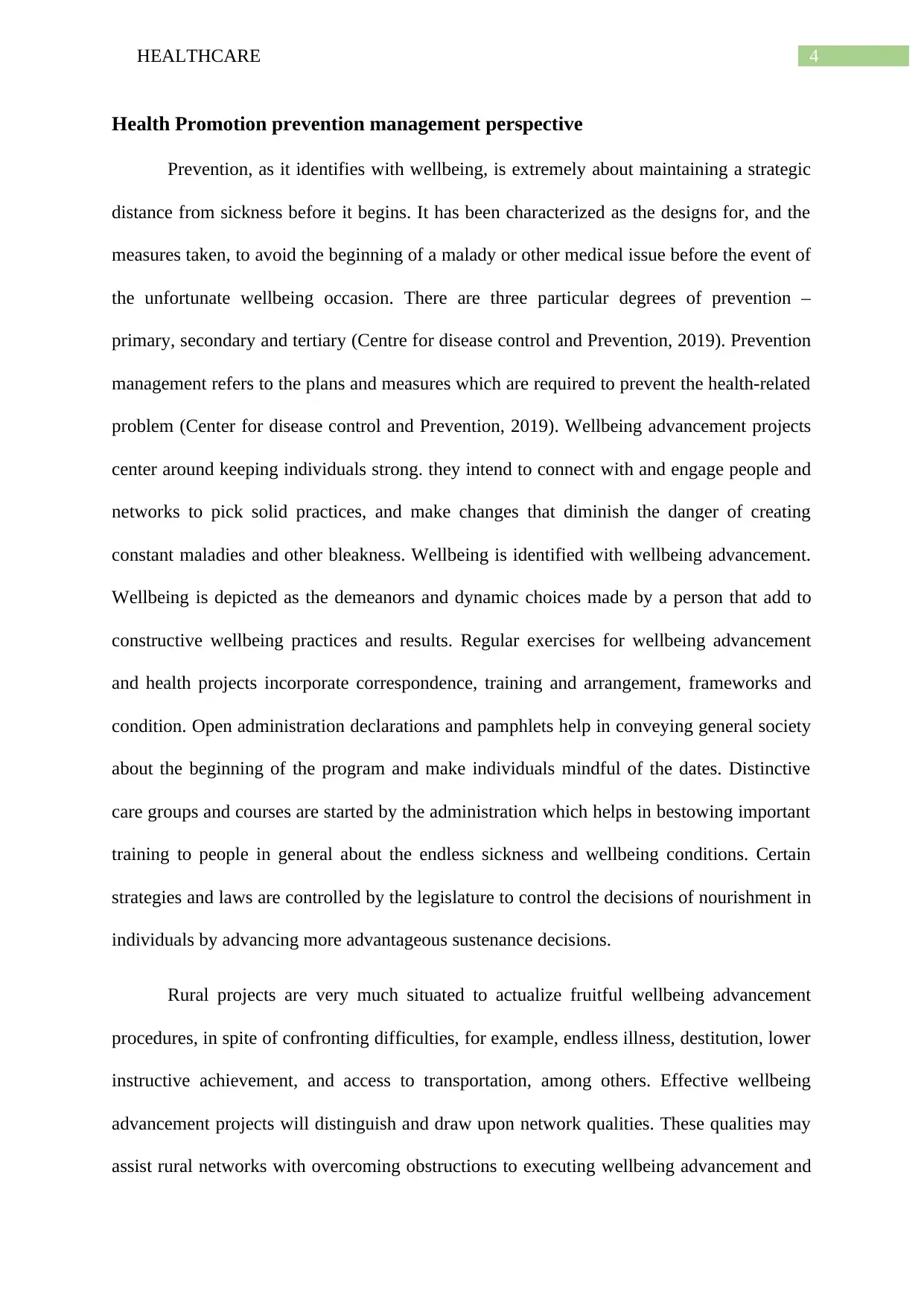
4HEALTHCARE
Health Promotion prevention management perspective
Prevention, as it identifies with wellbeing, is extremely about maintaining a strategic
distance from sickness before it begins. It has been characterized as the designs for, and the
measures taken, to avoid the beginning of a malady or other medical issue before the event of
the unfortunate wellbeing occasion. There are three particular degrees of prevention –
primary, secondary and tertiary (Centre for disease control and Prevention, 2019). Prevention
management refers to the plans and measures which are required to prevent the health-related
problem (Center for disease control and Prevention, 2019). Wellbeing advancement projects
center around keeping individuals strong. they intend to connect with and engage people and
networks to pick solid practices, and make changes that diminish the danger of creating
constant maladies and other bleakness. Wellbeing is identified with wellbeing advancement.
Wellbeing is depicted as the demeanors and dynamic choices made by a person that add to
constructive wellbeing practices and results. Regular exercises for wellbeing advancement
and health projects incorporate correspondence, training and arrangement, frameworks and
condition. Open administration declarations and pamphlets help in conveying general society
about the beginning of the program and make individuals mindful of the dates. Distinctive
care groups and courses are started by the administration which helps in bestowing important
training to people in general about the endless sickness and wellbeing conditions. Certain
strategies and laws are controlled by the legislature to control the decisions of nourishment in
individuals by advancing more advantageous sustenance decisions.
Rural projects are very much situated to actualize fruitful wellbeing advancement
procedures, in spite of confronting difficulties, for example, endless illness, destitution, lower
instructive achievement, and access to transportation, among others. Effective wellbeing
advancement projects will distinguish and draw upon network qualities. These qualities may
assist rural networks with overcoming obstructions to executing wellbeing advancement and
Health Promotion prevention management perspective
Prevention, as it identifies with wellbeing, is extremely about maintaining a strategic
distance from sickness before it begins. It has been characterized as the designs for, and the
measures taken, to avoid the beginning of a malady or other medical issue before the event of
the unfortunate wellbeing occasion. There are three particular degrees of prevention –
primary, secondary and tertiary (Centre for disease control and Prevention, 2019). Prevention
management refers to the plans and measures which are required to prevent the health-related
problem (Center for disease control and Prevention, 2019). Wellbeing advancement projects
center around keeping individuals strong. they intend to connect with and engage people and
networks to pick solid practices, and make changes that diminish the danger of creating
constant maladies and other bleakness. Wellbeing is identified with wellbeing advancement.
Wellbeing is depicted as the demeanors and dynamic choices made by a person that add to
constructive wellbeing practices and results. Regular exercises for wellbeing advancement
and health projects incorporate correspondence, training and arrangement, frameworks and
condition. Open administration declarations and pamphlets help in conveying general society
about the beginning of the program and make individuals mindful of the dates. Distinctive
care groups and courses are started by the administration which helps in bestowing important
training to people in general about the endless sickness and wellbeing conditions. Certain
strategies and laws are controlled by the legislature to control the decisions of nourishment in
individuals by advancing more advantageous sustenance decisions.
Rural projects are very much situated to actualize fruitful wellbeing advancement
procedures, in spite of confronting difficulties, for example, endless illness, destitution, lower
instructive achievement, and access to transportation, among others. Effective wellbeing
advancement projects will distinguish and draw upon network qualities. These qualities may
assist rural networks with overcoming obstructions to executing wellbeing advancement and
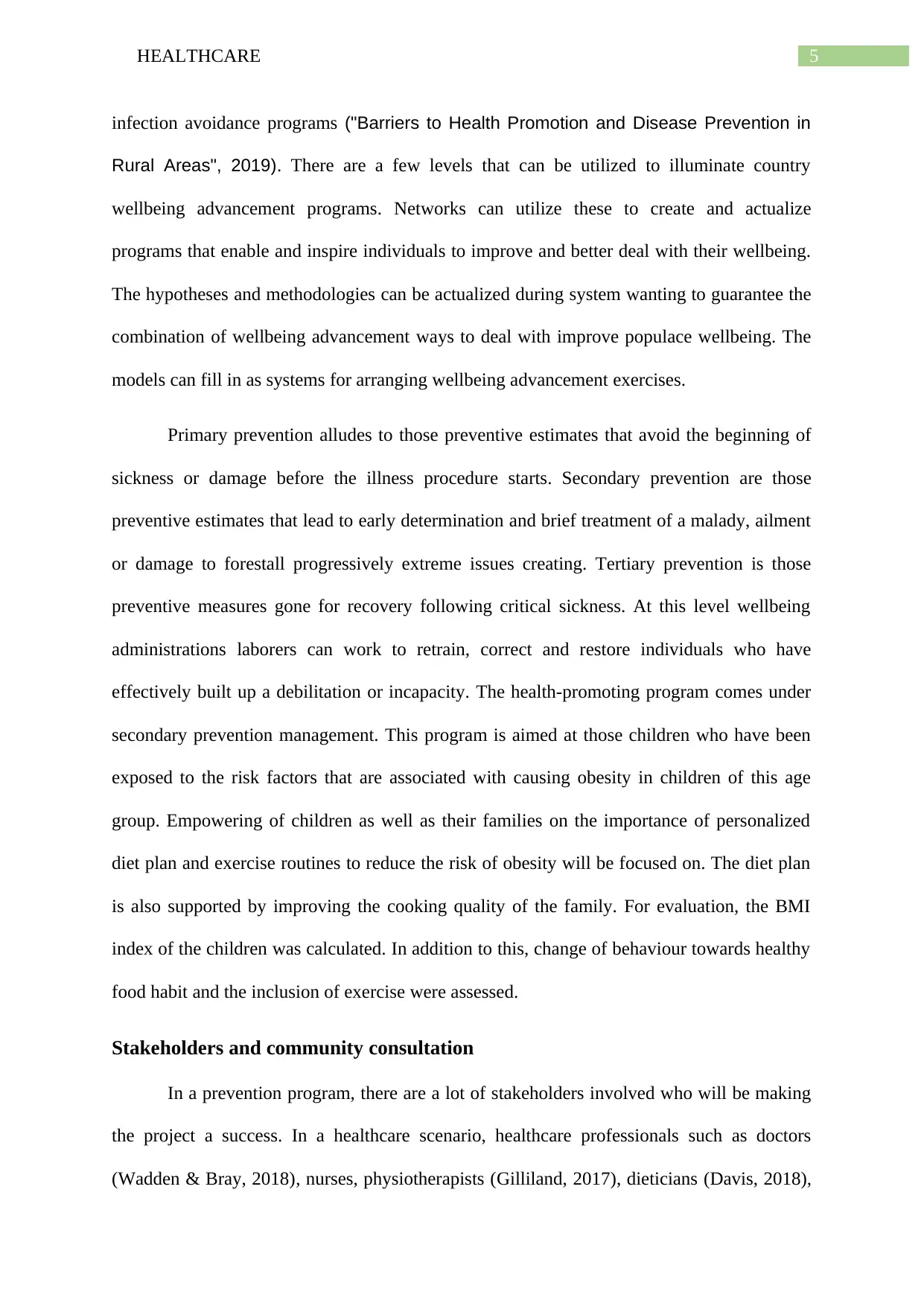
5HEALTHCARE
infection avoidance programs ("Barriers to Health Promotion and Disease Prevention in
Rural Areas", 2019). There are a few levels that can be utilized to illuminate country
wellbeing advancement programs. Networks can utilize these to create and actualize
programs that enable and inspire individuals to improve and better deal with their wellbeing.
The hypotheses and methodologies can be actualized during system wanting to guarantee the
combination of wellbeing advancement ways to deal with improve populace wellbeing. The
models can fill in as systems for arranging wellbeing advancement exercises.
Primary prevention alludes to those preventive estimates that avoid the beginning of
sickness or damage before the illness procedure starts. Secondary prevention are those
preventive estimates that lead to early determination and brief treatment of a malady, ailment
or damage to forestall progressively extreme issues creating. Tertiary prevention is those
preventive measures gone for recovery following critical sickness. At this level wellbeing
administrations laborers can work to retrain, correct and restore individuals who have
effectively built up a debilitation or incapacity. The health-promoting program comes under
secondary prevention management. This program is aimed at those children who have been
exposed to the risk factors that are associated with causing obesity in children of this age
group. Empowering of children as well as their families on the importance of personalized
diet plan and exercise routines to reduce the risk of obesity will be focused on. The diet plan
is also supported by improving the cooking quality of the family. For evaluation, the BMI
index of the children was calculated. In addition to this, change of behaviour towards healthy
food habit and the inclusion of exercise were assessed.
Stakeholders and community consultation
In a prevention program, there are a lot of stakeholders involved who will be making
the project a success. In a healthcare scenario, healthcare professionals such as doctors
(Wadden & Bray, 2018), nurses, physiotherapists (Gilliland, 2017), dieticians (Davis, 2018),
infection avoidance programs ("Barriers to Health Promotion and Disease Prevention in
Rural Areas", 2019). There are a few levels that can be utilized to illuminate country
wellbeing advancement programs. Networks can utilize these to create and actualize
programs that enable and inspire individuals to improve and better deal with their wellbeing.
The hypotheses and methodologies can be actualized during system wanting to guarantee the
combination of wellbeing advancement ways to deal with improve populace wellbeing. The
models can fill in as systems for arranging wellbeing advancement exercises.
Primary prevention alludes to those preventive estimates that avoid the beginning of
sickness or damage before the illness procedure starts. Secondary prevention are those
preventive estimates that lead to early determination and brief treatment of a malady, ailment
or damage to forestall progressively extreme issues creating. Tertiary prevention is those
preventive measures gone for recovery following critical sickness. At this level wellbeing
administrations laborers can work to retrain, correct and restore individuals who have
effectively built up a debilitation or incapacity. The health-promoting program comes under
secondary prevention management. This program is aimed at those children who have been
exposed to the risk factors that are associated with causing obesity in children of this age
group. Empowering of children as well as their families on the importance of personalized
diet plan and exercise routines to reduce the risk of obesity will be focused on. The diet plan
is also supported by improving the cooking quality of the family. For evaluation, the BMI
index of the children was calculated. In addition to this, change of behaviour towards healthy
food habit and the inclusion of exercise were assessed.
Stakeholders and community consultation
In a prevention program, there are a lot of stakeholders involved who will be making
the project a success. In a healthcare scenario, healthcare professionals such as doctors
(Wadden & Bray, 2018), nurses, physiotherapists (Gilliland, 2017), dieticians (Davis, 2018),
⊘ This is a preview!⊘
Do you want full access?
Subscribe today to unlock all pages.

Trusted by 1+ million students worldwide
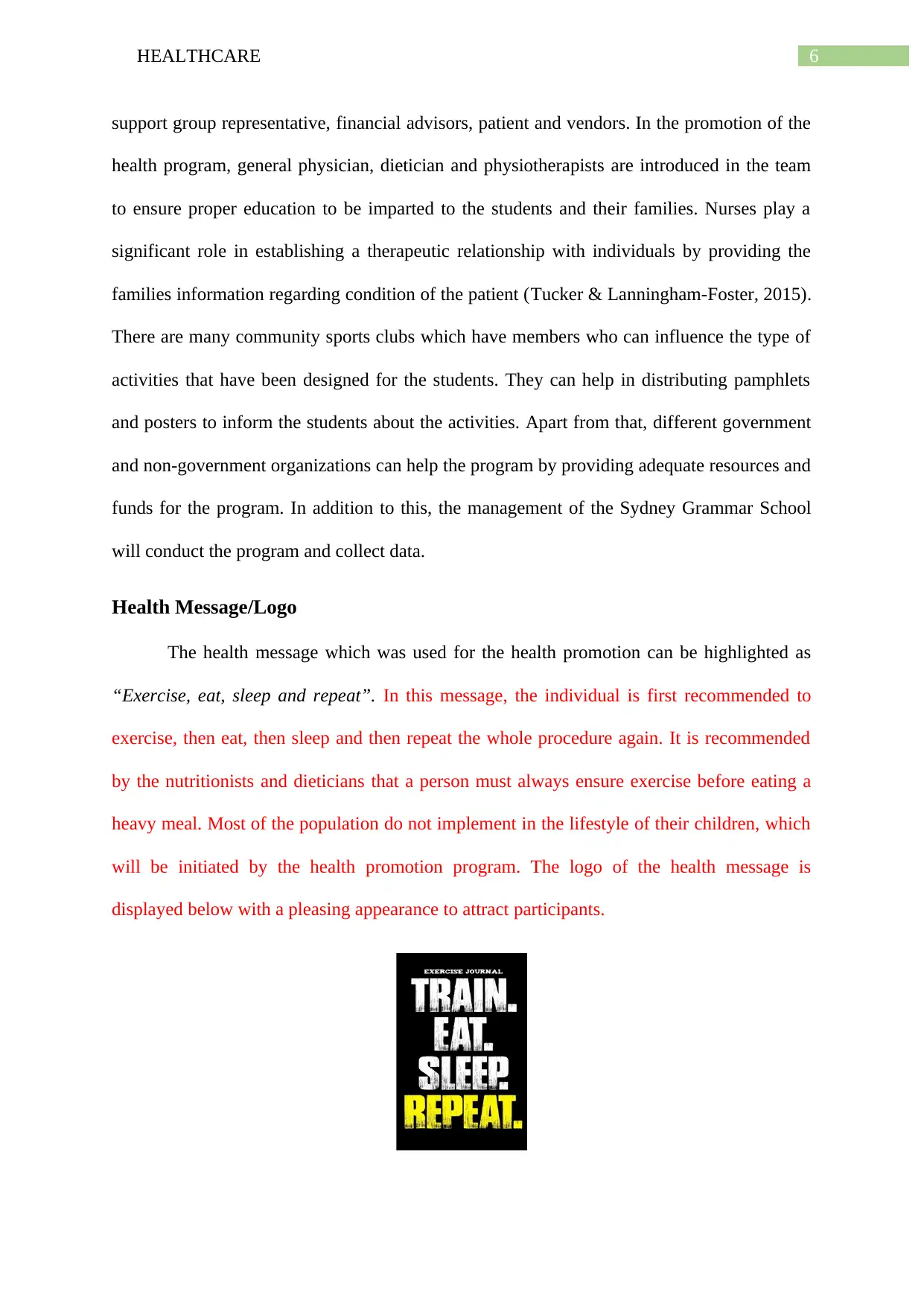
6HEALTHCARE
support group representative, financial advisors, patient and vendors. In the promotion of the
health program, general physician, dietician and physiotherapists are introduced in the team
to ensure proper education to be imparted to the students and their families. Nurses play a
significant role in establishing a therapeutic relationship with individuals by providing the
families information regarding condition of the patient (Tucker & Lanningham-Foster, 2015).
There are many community sports clubs which have members who can influence the type of
activities that have been designed for the students. They can help in distributing pamphlets
and posters to inform the students about the activities. Apart from that, different government
and non-government organizations can help the program by providing adequate resources and
funds for the program. In addition to this, the management of the Sydney Grammar School
will conduct the program and collect data.
Health Message/Logo
The health message which was used for the health promotion can be highlighted as
“Exercise, eat, sleep and repeat”. In this message, the individual is first recommended to
exercise, then eat, then sleep and then repeat the whole procedure again. It is recommended
by the nutritionists and dieticians that a person must always ensure exercise before eating a
heavy meal. Most of the population do not implement in the lifestyle of their children, which
will be initiated by the health promotion program. The logo of the health message is
displayed below with a pleasing appearance to attract participants.
support group representative, financial advisors, patient and vendors. In the promotion of the
health program, general physician, dietician and physiotherapists are introduced in the team
to ensure proper education to be imparted to the students and their families. Nurses play a
significant role in establishing a therapeutic relationship with individuals by providing the
families information regarding condition of the patient (Tucker & Lanningham-Foster, 2015).
There are many community sports clubs which have members who can influence the type of
activities that have been designed for the students. They can help in distributing pamphlets
and posters to inform the students about the activities. Apart from that, different government
and non-government organizations can help the program by providing adequate resources and
funds for the program. In addition to this, the management of the Sydney Grammar School
will conduct the program and collect data.
Health Message/Logo
The health message which was used for the health promotion can be highlighted as
“Exercise, eat, sleep and repeat”. In this message, the individual is first recommended to
exercise, then eat, then sleep and then repeat the whole procedure again. It is recommended
by the nutritionists and dieticians that a person must always ensure exercise before eating a
heavy meal. Most of the population do not implement in the lifestyle of their children, which
will be initiated by the health promotion program. The logo of the health message is
displayed below with a pleasing appearance to attract participants.
Paraphrase This Document
Need a fresh take? Get an instant paraphrase of this document with our AI Paraphraser
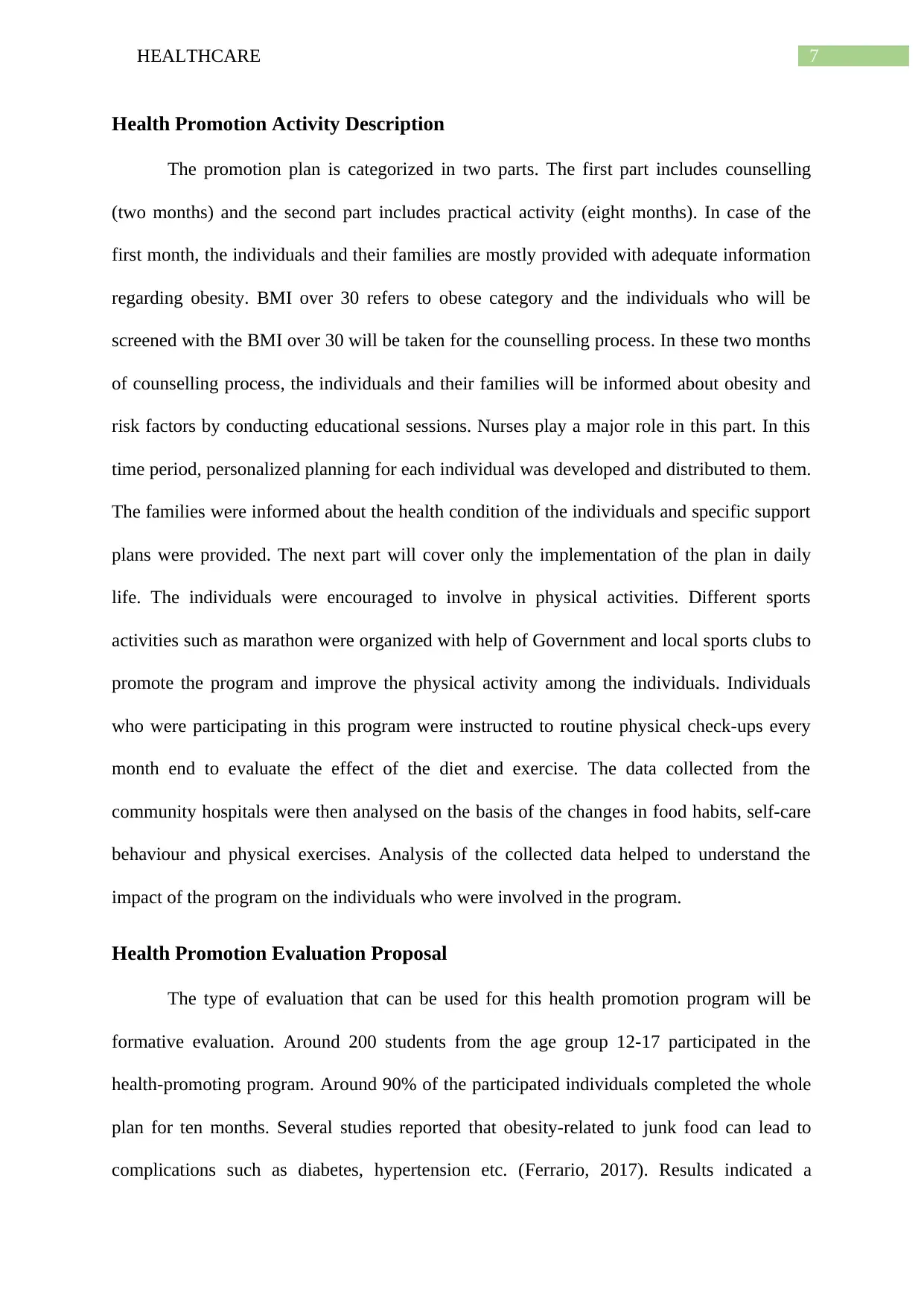
7HEALTHCARE
Health Promotion Activity Description
The promotion plan is categorized in two parts. The first part includes counselling
(two months) and the second part includes practical activity (eight months). In case of the
first month, the individuals and their families are mostly provided with adequate information
regarding obesity. BMI over 30 refers to obese category and the individuals who will be
screened with the BMI over 30 will be taken for the counselling process. In these two months
of counselling process, the individuals and their families will be informed about obesity and
risk factors by conducting educational sessions. Nurses play a major role in this part. In this
time period, personalized planning for each individual was developed and distributed to them.
The families were informed about the health condition of the individuals and specific support
plans were provided. The next part will cover only the implementation of the plan in daily
life. The individuals were encouraged to involve in physical activities. Different sports
activities such as marathon were organized with help of Government and local sports clubs to
promote the program and improve the physical activity among the individuals. Individuals
who were participating in this program were instructed to routine physical check-ups every
month end to evaluate the effect of the diet and exercise. The data collected from the
community hospitals were then analysed on the basis of the changes in food habits, self-care
behaviour and physical exercises. Analysis of the collected data helped to understand the
impact of the program on the individuals who were involved in the program.
Health Promotion Evaluation Proposal
The type of evaluation that can be used for this health promotion program will be
formative evaluation. Around 200 students from the age group 12-17 participated in the
health-promoting program. Around 90% of the participated individuals completed the whole
plan for ten months. Several studies reported that obesity-related to junk food can lead to
complications such as diabetes, hypertension etc. (Ferrario, 2017). Results indicated a
Health Promotion Activity Description
The promotion plan is categorized in two parts. The first part includes counselling
(two months) and the second part includes practical activity (eight months). In case of the
first month, the individuals and their families are mostly provided with adequate information
regarding obesity. BMI over 30 refers to obese category and the individuals who will be
screened with the BMI over 30 will be taken for the counselling process. In these two months
of counselling process, the individuals and their families will be informed about obesity and
risk factors by conducting educational sessions. Nurses play a major role in this part. In this
time period, personalized planning for each individual was developed and distributed to them.
The families were informed about the health condition of the individuals and specific support
plans were provided. The next part will cover only the implementation of the plan in daily
life. The individuals were encouraged to involve in physical activities. Different sports
activities such as marathon were organized with help of Government and local sports clubs to
promote the program and improve the physical activity among the individuals. Individuals
who were participating in this program were instructed to routine physical check-ups every
month end to evaluate the effect of the diet and exercise. The data collected from the
community hospitals were then analysed on the basis of the changes in food habits, self-care
behaviour and physical exercises. Analysis of the collected data helped to understand the
impact of the program on the individuals who were involved in the program.
Health Promotion Evaluation Proposal
The type of evaluation that can be used for this health promotion program will be
formative evaluation. Around 200 students from the age group 12-17 participated in the
health-promoting program. Around 90% of the participated individuals completed the whole
plan for ten months. Several studies reported that obesity-related to junk food can lead to
complications such as diabetes, hypertension etc. (Ferrario, 2017). Results indicated a
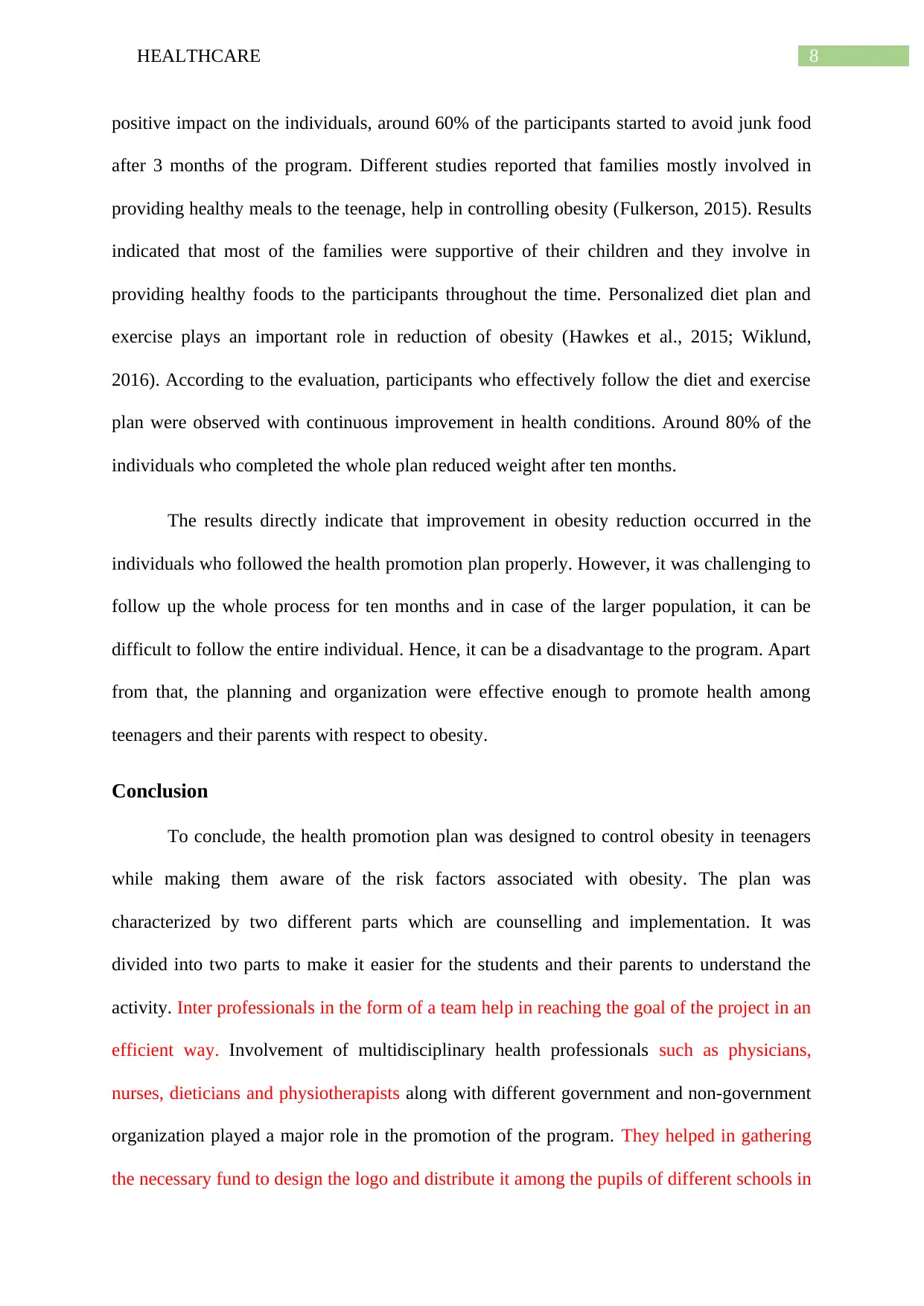
8HEALTHCARE
positive impact on the individuals, around 60% of the participants started to avoid junk food
after 3 months of the program. Different studies reported that families mostly involved in
providing healthy meals to the teenage, help in controlling obesity (Fulkerson, 2015). Results
indicated that most of the families were supportive of their children and they involve in
providing healthy foods to the participants throughout the time. Personalized diet plan and
exercise plays an important role in reduction of obesity (Hawkes et al., 2015; Wiklund,
2016). According to the evaluation, participants who effectively follow the diet and exercise
plan were observed with continuous improvement in health conditions. Around 80% of the
individuals who completed the whole plan reduced weight after ten months.
The results directly indicate that improvement in obesity reduction occurred in the
individuals who followed the health promotion plan properly. However, it was challenging to
follow up the whole process for ten months and in case of the larger population, it can be
difficult to follow the entire individual. Hence, it can be a disadvantage to the program. Apart
from that, the planning and organization were effective enough to promote health among
teenagers and their parents with respect to obesity.
Conclusion
To conclude, the health promotion plan was designed to control obesity in teenagers
while making them aware of the risk factors associated with obesity. The plan was
characterized by two different parts which are counselling and implementation. It was
divided into two parts to make it easier for the students and their parents to understand the
activity. Inter professionals in the form of a team help in reaching the goal of the project in an
efficient way. Involvement of multidisciplinary health professionals such as physicians,
nurses, dieticians and physiotherapists along with different government and non-government
organization played a major role in the promotion of the program. They helped in gathering
the necessary fund to design the logo and distribute it among the pupils of different schools in
positive impact on the individuals, around 60% of the participants started to avoid junk food
after 3 months of the program. Different studies reported that families mostly involved in
providing healthy meals to the teenage, help in controlling obesity (Fulkerson, 2015). Results
indicated that most of the families were supportive of their children and they involve in
providing healthy foods to the participants throughout the time. Personalized diet plan and
exercise plays an important role in reduction of obesity (Hawkes et al., 2015; Wiklund,
2016). According to the evaluation, participants who effectively follow the diet and exercise
plan were observed with continuous improvement in health conditions. Around 80% of the
individuals who completed the whole plan reduced weight after ten months.
The results directly indicate that improvement in obesity reduction occurred in the
individuals who followed the health promotion plan properly. However, it was challenging to
follow up the whole process for ten months and in case of the larger population, it can be
difficult to follow the entire individual. Hence, it can be a disadvantage to the program. Apart
from that, the planning and organization were effective enough to promote health among
teenagers and their parents with respect to obesity.
Conclusion
To conclude, the health promotion plan was designed to control obesity in teenagers
while making them aware of the risk factors associated with obesity. The plan was
characterized by two different parts which are counselling and implementation. It was
divided into two parts to make it easier for the students and their parents to understand the
activity. Inter professionals in the form of a team help in reaching the goal of the project in an
efficient way. Involvement of multidisciplinary health professionals such as physicians,
nurses, dieticians and physiotherapists along with different government and non-government
organization played a major role in the promotion of the program. They helped in gathering
the necessary fund to design the logo and distribute it among the pupils of different schools in
⊘ This is a preview!⊘
Do you want full access?
Subscribe today to unlock all pages.

Trusted by 1+ million students worldwide
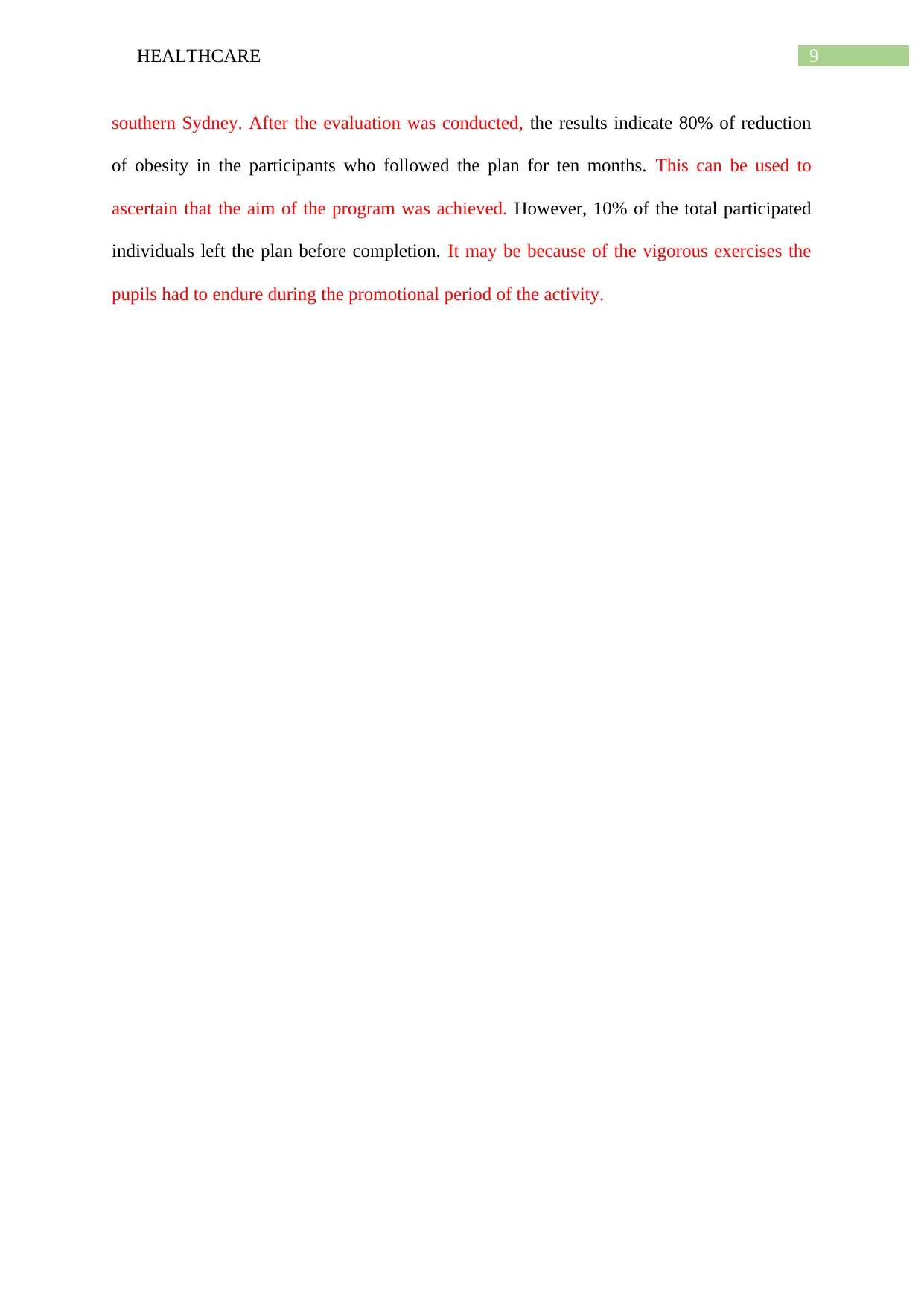
9HEALTHCARE
southern Sydney. After the evaluation was conducted, the results indicate 80% of reduction
of obesity in the participants who followed the plan for ten months. This can be used to
ascertain that the aim of the program was achieved. However, 10% of the total participated
individuals left the plan before completion. It may be because of the vigorous exercises the
pupils had to endure during the promotional period of the activity.
southern Sydney. After the evaluation was conducted, the results indicate 80% of reduction
of obesity in the participants who followed the plan for ten months. This can be used to
ascertain that the aim of the program was achieved. However, 10% of the total participated
individuals left the plan before completion. It may be because of the vigorous exercises the
pupils had to endure during the promotional period of the activity.
Paraphrase This Document
Need a fresh take? Get an instant paraphrase of this document with our AI Paraphraser
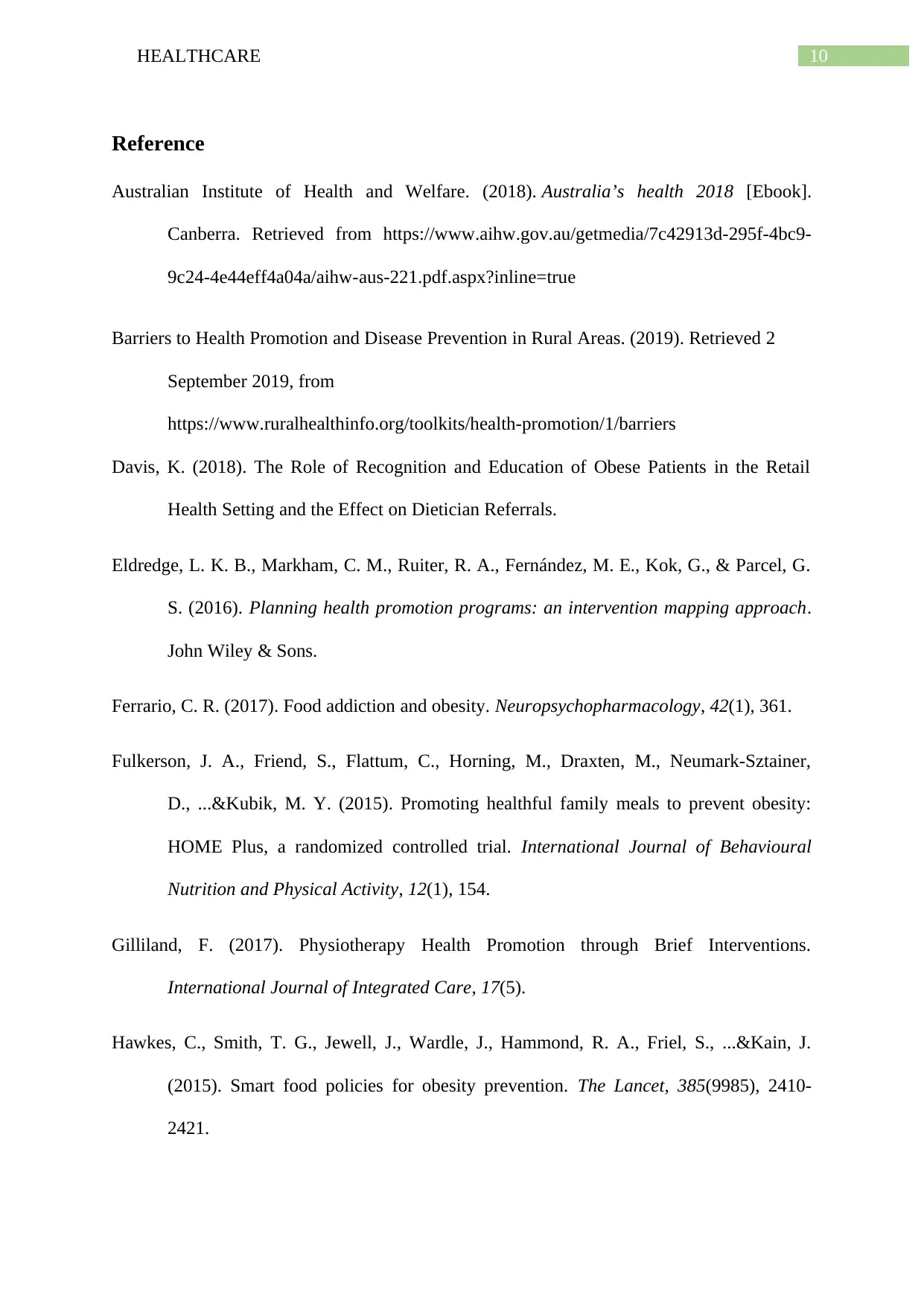
10HEALTHCARE
Reference
Australian Institute of Health and Welfare. (2018). Australia’s health 2018 [Ebook].
Canberra. Retrieved from https://www.aihw.gov.au/getmedia/7c42913d-295f-4bc9-
9c24-4e44eff4a04a/aihw-aus-221.pdf.aspx?inline=true
Barriers to Health Promotion and Disease Prevention in Rural Areas. (2019). Retrieved 2
September 2019, from
https://www.ruralhealthinfo.org/toolkits/health-promotion/1/barriers
Davis, K. (2018). The Role of Recognition and Education of Obese Patients in the Retail
Health Setting and the Effect on Dietician Referrals.
Eldredge, L. K. B., Markham, C. M., Ruiter, R. A., Fernández, M. E., Kok, G., & Parcel, G.
S. (2016). Planning health promotion programs: an intervention mapping approach.
John Wiley & Sons.
Ferrario, C. R. (2017). Food addiction and obesity. Neuropsychopharmacology, 42(1), 361.
Fulkerson, J. A., Friend, S., Flattum, C., Horning, M., Draxten, M., Neumark-Sztainer,
D., ...&Kubik, M. Y. (2015). Promoting healthful family meals to prevent obesity:
HOME Plus, a randomized controlled trial. International Journal of Behavioural
Nutrition and Physical Activity, 12(1), 154.
Gilliland, F. (2017). Physiotherapy Health Promotion through Brief Interventions.
International Journal of Integrated Care, 17(5).
Hawkes, C., Smith, T. G., Jewell, J., Wardle, J., Hammond, R. A., Friel, S., ...&Kain, J.
(2015). Smart food policies for obesity prevention. The Lancet, 385(9985), 2410-
2421.
Reference
Australian Institute of Health and Welfare. (2018). Australia’s health 2018 [Ebook].
Canberra. Retrieved from https://www.aihw.gov.au/getmedia/7c42913d-295f-4bc9-
9c24-4e44eff4a04a/aihw-aus-221.pdf.aspx?inline=true
Barriers to Health Promotion and Disease Prevention in Rural Areas. (2019). Retrieved 2
September 2019, from
https://www.ruralhealthinfo.org/toolkits/health-promotion/1/barriers
Davis, K. (2018). The Role of Recognition and Education of Obese Patients in the Retail
Health Setting and the Effect on Dietician Referrals.
Eldredge, L. K. B., Markham, C. M., Ruiter, R. A., Fernández, M. E., Kok, G., & Parcel, G.
S. (2016). Planning health promotion programs: an intervention mapping approach.
John Wiley & Sons.
Ferrario, C. R. (2017). Food addiction and obesity. Neuropsychopharmacology, 42(1), 361.
Fulkerson, J. A., Friend, S., Flattum, C., Horning, M., Draxten, M., Neumark-Sztainer,
D., ...&Kubik, M. Y. (2015). Promoting healthful family meals to prevent obesity:
HOME Plus, a randomized controlled trial. International Journal of Behavioural
Nutrition and Physical Activity, 12(1), 154.
Gilliland, F. (2017). Physiotherapy Health Promotion through Brief Interventions.
International Journal of Integrated Care, 17(5).
Hawkes, C., Smith, T. G., Jewell, J., Wardle, J., Hammond, R. A., Friel, S., ...&Kain, J.
(2015). Smart food policies for obesity prevention. The Lancet, 385(9985), 2410-
2421.
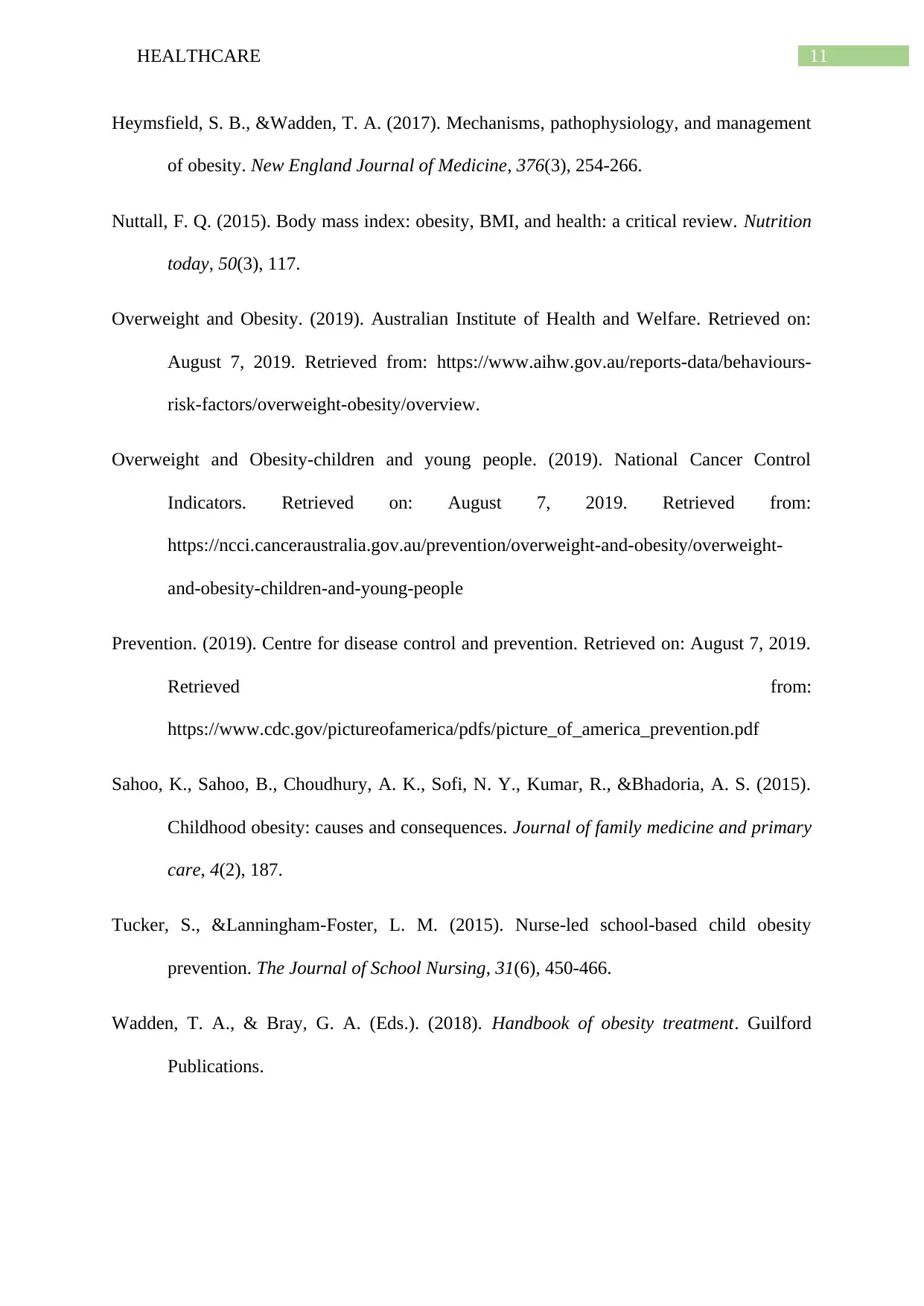
11HEALTHCARE
Heymsfield, S. B., &Wadden, T. A. (2017). Mechanisms, pathophysiology, and management
of obesity. New England Journal of Medicine, 376(3), 254-266.
Nuttall, F. Q. (2015). Body mass index: obesity, BMI, and health: a critical review. Nutrition
today, 50(3), 117.
Overweight and Obesity. (2019). Australian Institute of Health and Welfare. Retrieved on:
August 7, 2019. Retrieved from: https://www.aihw.gov.au/reports-data/behaviours-
risk-factors/overweight-obesity/overview.
Overweight and Obesity-children and young people. (2019). National Cancer Control
Indicators. Retrieved on: August 7, 2019. Retrieved from:
https://ncci.canceraustralia.gov.au/prevention/overweight-and-obesity/overweight-
and-obesity-children-and-young-people
Prevention. (2019). Centre for disease control and prevention. Retrieved on: August 7, 2019.
Retrieved from:
https://www.cdc.gov/pictureofamerica/pdfs/picture_of_america_prevention.pdf
Sahoo, K., Sahoo, B., Choudhury, A. K., Sofi, N. Y., Kumar, R., &Bhadoria, A. S. (2015).
Childhood obesity: causes and consequences. Journal of family medicine and primary
care, 4(2), 187.
Tucker, S., &Lanningham-Foster, L. M. (2015). Nurse-led school-based child obesity
prevention. The Journal of School Nursing, 31(6), 450-466.
Wadden, T. A., & Bray, G. A. (Eds.). (2018). Handbook of obesity treatment. Guilford
Publications.
Heymsfield, S. B., &Wadden, T. A. (2017). Mechanisms, pathophysiology, and management
of obesity. New England Journal of Medicine, 376(3), 254-266.
Nuttall, F. Q. (2015). Body mass index: obesity, BMI, and health: a critical review. Nutrition
today, 50(3), 117.
Overweight and Obesity. (2019). Australian Institute of Health and Welfare. Retrieved on:
August 7, 2019. Retrieved from: https://www.aihw.gov.au/reports-data/behaviours-
risk-factors/overweight-obesity/overview.
Overweight and Obesity-children and young people. (2019). National Cancer Control
Indicators. Retrieved on: August 7, 2019. Retrieved from:
https://ncci.canceraustralia.gov.au/prevention/overweight-and-obesity/overweight-
and-obesity-children-and-young-people
Prevention. (2019). Centre for disease control and prevention. Retrieved on: August 7, 2019.
Retrieved from:
https://www.cdc.gov/pictureofamerica/pdfs/picture_of_america_prevention.pdf
Sahoo, K., Sahoo, B., Choudhury, A. K., Sofi, N. Y., Kumar, R., &Bhadoria, A. S. (2015).
Childhood obesity: causes and consequences. Journal of family medicine and primary
care, 4(2), 187.
Tucker, S., &Lanningham-Foster, L. M. (2015). Nurse-led school-based child obesity
prevention. The Journal of School Nursing, 31(6), 450-466.
Wadden, T. A., & Bray, G. A. (Eds.). (2018). Handbook of obesity treatment. Guilford
Publications.
⊘ This is a preview!⊘
Do you want full access?
Subscribe today to unlock all pages.

Trusted by 1+ million students worldwide
1 out of 13
Related Documents
Your All-in-One AI-Powered Toolkit for Academic Success.
+13062052269
info@desklib.com
Available 24*7 on WhatsApp / Email
![[object Object]](/_next/static/media/star-bottom.7253800d.svg)
Unlock your academic potential
Copyright © 2020–2025 A2Z Services. All Rights Reserved. Developed and managed by ZUCOL.




